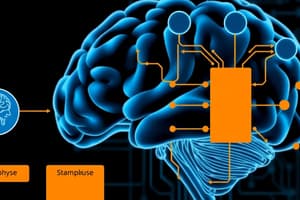Podcast
Questions and Answers
What are the three discrete stages of information processing in the motor system?
What are the three discrete stages of information processing in the motor system?
- Stimulus identification, Response selection, Response programming (correct)
- Stimulus analysis, Response programming, Feedback generation
- Response execution, Response perception, Motor planning
- Input selection, Reaction timing, Movement execution
In the stimulus identification stage, which process is primarily involved?
In the stimulus identification stage, which process is primarily involved?
- Organizing a response plan
- Calculating movement execution time
- Analyzing various sources of stimuli (correct)
- Deciding which muscles to activate
How does the response selection stage primarily contribute to the information processing?
How does the response selection stage primarily contribute to the information processing?
- It generates feedback for future movements.
- It estimates the timing of signal responses.
- It transforms sensory inputs into movement outputs. (correct)
- It assembles a physical response to stimuli.
What is the role of lower level mechanisms in the response programming stage?
What is the role of lower level mechanisms in the response programming stage?
What does reaction time (RT) primarily measure?
What does reaction time (RT) primarily measure?
Which components are included in measuring reaction time?
Which components are included in measuring reaction time?
Which factor is NOT considered during the stimulus identification stage?
Which factor is NOT considered during the stimulus identification stage?
In the context of motor processing, what does the term 'pre-motor time' refer to?
In the context of motor processing, what does the term 'pre-motor time' refer to?
What type of responses may be selected during response selection stage?
What type of responses may be selected during response selection stage?
Which of the following best describes 'movement time' in relation to reaction time?
Which of the following best describes 'movement time' in relation to reaction time?
Which statement accurately describes Hick's Law?
Which statement accurately describes Hick's Law?
What was the main conclusion of Fitts' Law regarding speed and accuracy?
What was the main conclusion of Fitts' Law regarding speed and accuracy?
According to the information about reaction time paradigms, which type of reaction time is measured when there is one stimulus and a corresponding single response?
According to the information about reaction time paradigms, which type of reaction time is measured when there is one stimulus and a corresponding single response?
What effect does the distance of movement have on reaction time?
What effect does the distance of movement have on reaction time?
Which option best summarizes the relationship between movement time and accuracy as studied by Woodworth?
Which option best summarizes the relationship between movement time and accuracy as studied by Woodworth?
How does the number of stimulus-response pairs affect choice reaction time?
How does the number of stimulus-response pairs affect choice reaction time?
In the context of rapid, continuous movements, what role does visual feedback play?
In the context of rapid, continuous movements, what role does visual feedback play?
What is the primary focus of the speed-accuracy trade-off?
What is the primary focus of the speed-accuracy trade-off?
What does a longer choice reaction time suggest about the stimulus-response alternatives?
What does a longer choice reaction time suggest about the stimulus-response alternatives?
Which factor is essential in Fitts' experiments concerning targeting accuracy?
Which factor is essential in Fitts' experiments concerning targeting accuracy?
Flashcards are hidden until you start studying
Study Notes
Information Processing in the Motor System
- Three stages of information processing:
- Stimulus identification
- Response selection
- Response programming
Stimulus identification
- Representation of environmental information
- Performer determines if information (stimulus) is present and how to identify it
- Analysis of stimuli from various sources, including visual, tactile, auditory, proprioceptive, olfaction, etc.
- Components of stimulus dimension (edges/colours, direction, speed)
Response Selection
- Translation of inputs (sensory modalities) to movement outputs
- Performer decides what response should be made
- Determines if a response is needed
- Selects the appropriate response
Response Programming
- Mechanisms retrieve and organize the plan of action to control movements
- Signals sent to muscles include timing, force, etc.
- Task: organize the motor system to produce desired movement
- Lower-level mechanisms (brainstem, spinal cord)
Reaction Time (RT)
- Time to prepare and initiate a movement from stimulus onset
- Used to identify environmental context and response initiation
- Assess individual's ability to anticipate actions and initiate responses
- Independent of movement time (MT)
- Types of reaction time paradigms:
- Simple RT
- Choice RT
- Discrimination RT
Factors Influencing RT (Decision Making)
- Number of stimulus-response (SR) alternatives
- Different stimuli (lights, etc.) require different responses.
- Increase in the number of pairs results in slower movements
- Hick’s Law
- Shortest RT when only one stimulus and one response
- RT increases with more S-R alternatives
Speed of Reaction Time and Movement Accuracy
- Time required for a movement changes as distance to be moved increases
- Speed-Accuracy Trade-off
- As movement speed increases, accuracy typically declines
- Woodworth (1899) showed that accuracy decreases with increasing line drawing speed.
- Fitts' Law (1954) mathematically described this trade-off
Speed-Accuracy Trade-off for Rapid Continuous Movements
- Fitts' Experiment
- Subjects tapped between two targets for a set time.
- Wider targets led to faster movement times (MT) compared to narrower targets.
- Visual feedback is used to "home in" on the target
- Fitt's Law
- Describes the integration of open and closed loop control processes (ballistic and more decelerating control to target)
Causes of Accuracy Deficits with Speed
- Requires further exploration
Studying That Suits You
Use AI to generate personalized quizzes and flashcards to suit your learning preferences.


